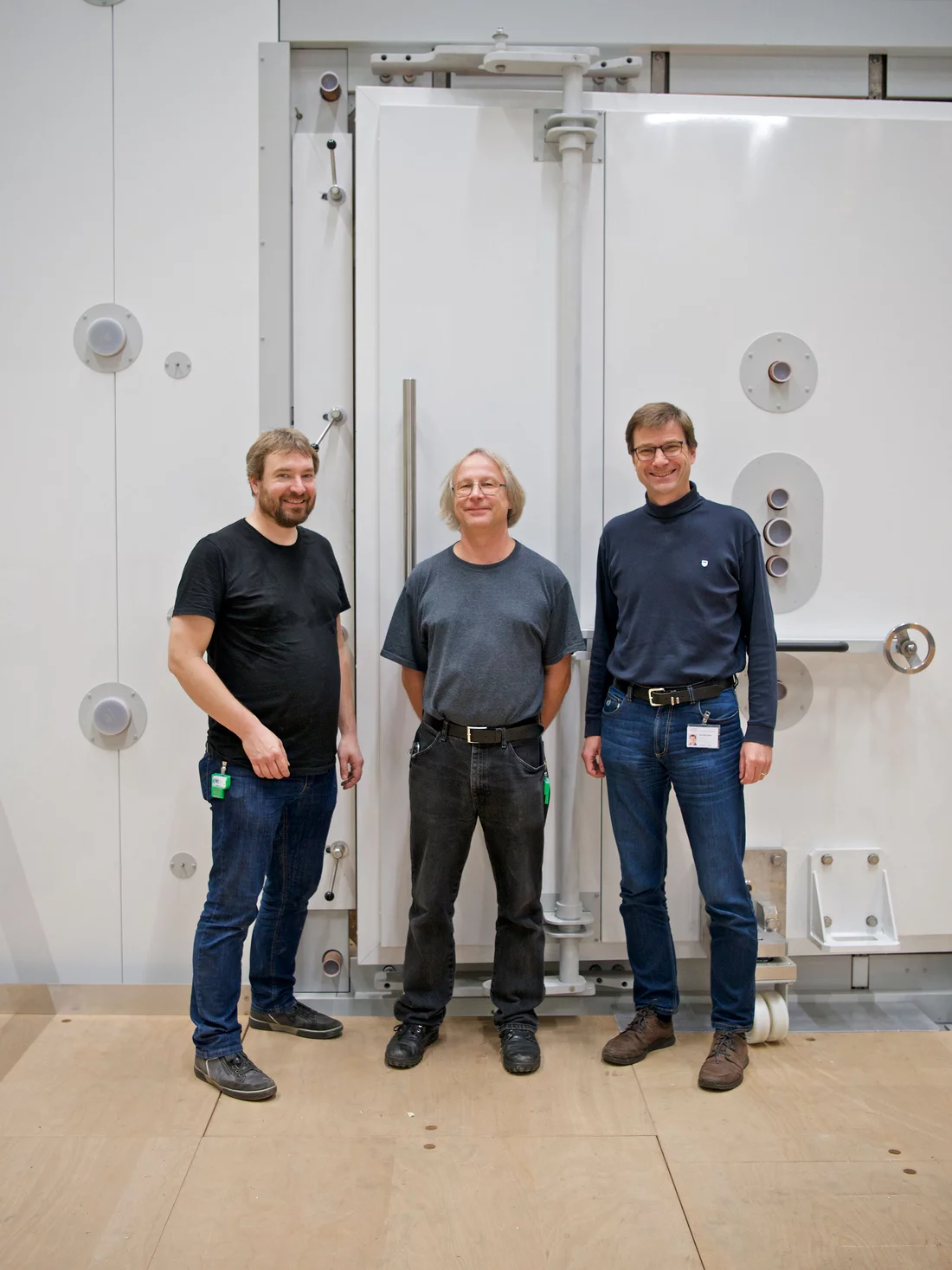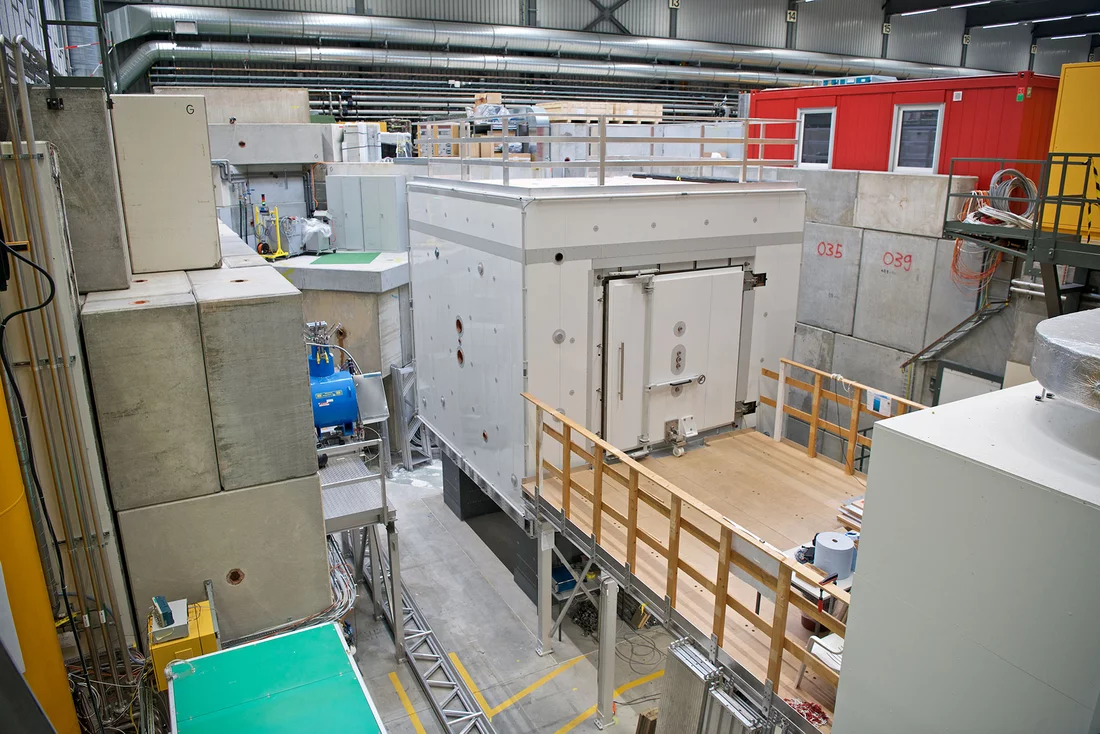At the Paul Scherrer Institute PSI in Villigen, Switzerland, researchers together with the company VACUUMSCHMELZE have built a room whose walls dampen any external magnetic influence by a hundred thousand times. The 25 cubic metre chamber is the world's best large magnetically shielded room . An experiment to be installed inside will help to clarify a fundamental question: Why does matter - and thus why do we - exist at all?
Georg Bison braces himself against a long lever and opens the outermost door, weighing tons, to a unique room. Inside the door and the 30 centimetre-thick white walls of the chamber are two layers of a nickel-iron alloy. "A magnetic field would rather flow through this highly magnetisable metal than through air, which is why it is so well suited for magnetic shielding," explains the physicist and specialist in magnetic field measurements. In addition, a layer of aluminium dampens temporally variable magnetic fields. But the walls, which are around five metres high, are only the shell for a second chamber, which fills the rest of the space at an interval of half a metre. "The gap is just big enough so that we can walk around here and install equipment," Bison explains: "In addition, the gap between the two chambers improves the shielding effect."
The walls of the inner chamber provide extra attenuation of the outer magnetic field. They contain four especially thick layers of the nickel-iron alloy. With a bit less effort than before, Bison opens two more large doors. Now we have a clear view of the inner space. The glossy dark-metal walls are around three metres wide and high. You might think you’re looking into a bank vault. But instead of locking up valuables here, scientists will use this room to unlock the secrets of neutrons, components of atomic nuclei. Every external magnetic field can disturb precision measurements of this kind, hence the elaborate construction.
Always surrounded by magnetic fields
"All the time and everywhere, there are magnetic fields," says Klaus Kirch, head of the Laboratory for Particle Physics at PSI and professor at ETH Zurich. It’s not only the earth’s magnetic field that is constantly present. "Almost everything in our environment generates magnetic fields on some level," the physicist explains, "whether it’s the watch on your wrist, a screwdriver, or the rebar in the concrete shielding at PSI and the hall crane in the building next-door." Even a lorry driving by two kilometres away generates a measurable magnetic signal. "The magnetically shielded room is our great defense against external influences," Kirch says.
From a distance you can see that the white, cube-shaped shielding room is surrounded by a wooden structure. "We chose wood because it is not magnetic," Bison explains: "The wooden cube is the carrier for a large coil system used to compensate for the earth's magnetic field and external field disturbances." In this way, the researchers can already attenuate magnetic disturbances from the outside before they reach the shielding. Further environmental influences are reduced by air conditioning that maintains the temperature inside the shielding at a constant 0.1 degree. Large granite pillars hold up the white cube. "The room has its own heavy foundation to dampen vibrations," explains Bison.
World record
"We have built the world’s best shielding room of this size," says Bernhard Lauss, project leader for the experiment: "We shield the static external magnetic field by a factor of a hundred thousand, and already at very low frequencies the shielding effect increases to more than a billion times." Kirch adds: "There are setups with an even higher shielding factor, but these are significantly smaller, too small to carry out our experiment. Among the walk-in rooms, we have by far the weakest magnetic field that has been realised anywhere in the world." Inside the chamber, the researchers measured a residual magnetic field of less than 150 picotesla (10-12 tesla). For comparison: The earth's magnetic field is 30 to 60 microtesla (10-6 tesla), several hundred thousand times stronger.
In a next step, the researchers will install an experiment in the chamber to search for a previously undiscovered physical quantity, the electric dipole moment of the neutron. Lauss explains: "Although the neutron is an electrically neutral particle on the outside, there could be a charge separation inside." If you pull a positive and a negative charge apart and place this dipole in an electric field, it aligns itself, just as a compass needle indicates the north-south direction in the magnetic field. "The experiment aims to determine whether the neutron rotates a little in an electric field, that is, whether there is such a dipole moment or not," the physicist explains.
Why did the antimatter disappear?
According to the current theory of elementary particle physics, the neutron would exhibit no measurable electric dipole moment. But this so-called standard model of particle physics cannot explain important observations. "We believe we know that the Big Bang that created the universe produced equal amounts of matter and antimatter," Kirch explains: "But today we can no longer see anything of this antimatter." Why has antimatter disappeared while at least part of the matter, the stuff that we are made of, remains? Various theories provide answers to this fundamental question and at the same time predict that the neutron must have an electric dipole moment of a certain magnitude. "If we measure such a dipole moment in our experiment, we can find out whether one of these theoretical predictions is correct or not," Lauss says.
For their experiment, the researchers need so-called ultracold neutrons, which move only slowly and therefore can be bottled up and examined for a few minutes. "At PSI, we have built the most powerful source internationally to generate as many such ultracold neutrons as possible for the experiment," explains Lauss. To detect an electrical dipole moment, the researchers will artificially generate a precisely defined magnetic field inside the magnetically shielded room and measure the reaction of the neutrons. Neutrons have a magnetic dipole moment that rotates with a certain frequency within the magnetic field. If they had an electric dipole moment, this rotation would speed up or slow down when an additional electric field is applied.
A result ten times more precise
Up to now, no such effect could be detected; all experiments have delivered a null result. The most precise measurements were made by the PSI researchers and other Swiss institutes with an international research collaboration at PSI, in a previous experiment called nEDM (for neutron and electric dipole moment). The new experiment, called n2EDM, should now deliver a result that is ten times more precise. Again 16 different groups with a total of 50 scientists are involved in the design, construction, and implementation of the project. "Without this cooperation, the experiment would not be possible," Kirch stresses. The shielding room was funded by ETH Zurich and PSI and with the support of the Swiss National Science Foundation.
This unique construction, which was installed at PSI, cost around 2.4 million Swiss francs. Twenty-five tons of the nickel-iron alloy were used, and five kilometres of cables were laid. Soon the container where neutrons can be exposed to the artificial magnetic field as well as the electric field in a vacuum is to be installed. With its diameter of two metres this vacuum tank, built by French partners from Caen, just fits through the large doors of the shielding room. Many other important contributions come from the other partners. For example, the National Metrology Institute of Germany (PTB) in Berlin contributed many important measurements of the building materials used for the magnetic shielding, guaranteeing that no parts with magnetic contamination would be used.
Despite delays due to the corona crisis, the researchers hope that the experiment will be fully assembled by the end of 2021 and will deliver the first measurement results after just two months in operation. "In comparison with the international competition in the USA, Canada, and France, we are one step ahead," Lauss says.
Text: Barbara Vonarburg
Further information on participating institutions:
https://www.psi.ch/en/nedm/collaborating-institutions
Contact
Prof. Dr. Klaus Kirch
Head of the Laboratory for Particle Physics
Paul Scherrer Institute, Forschungsstrasse 111, 5232 Villigen PSI, Switzerland
Telephone: +41 56 310 32 78; e-mail: klaus.kirch@psi.ch [German, English]
Dr. Bernhard Lauss
Laboratory for Particle Physics
Paul Scherrer Institute, Forschungsstrasse 111, 5232 Villigen PSI, Switzerland
Telephone: +41 56 310 46 47, e-mail: bernhard.lauss@psi.ch [German, English]
Copyright
PSI provides image and/or video material free of charge for media coverage of the content of the above text. Use of this material for other purposes is not permitted. This also includes the transfer of the image and video material into databases as well as sale by third parties.


